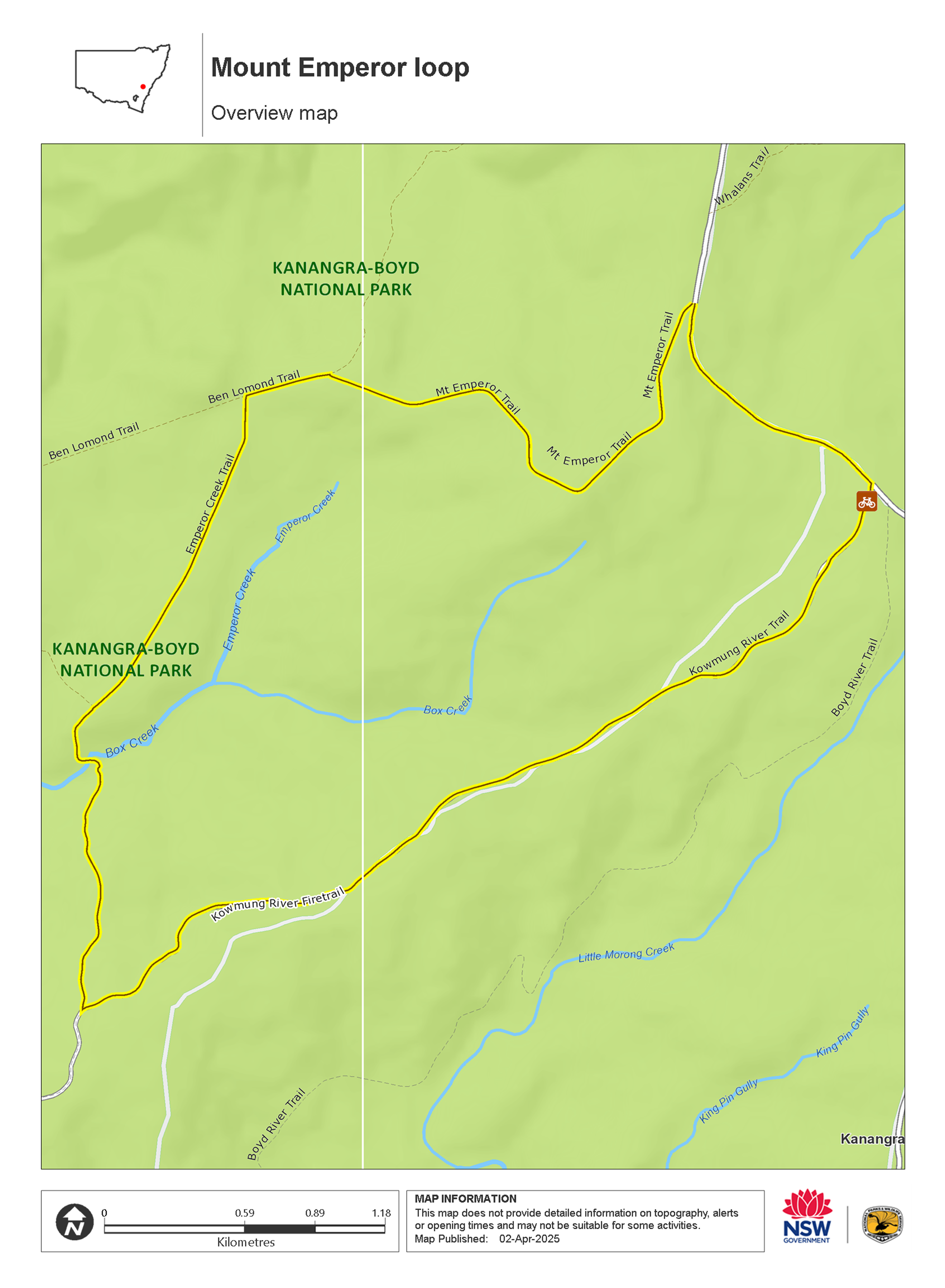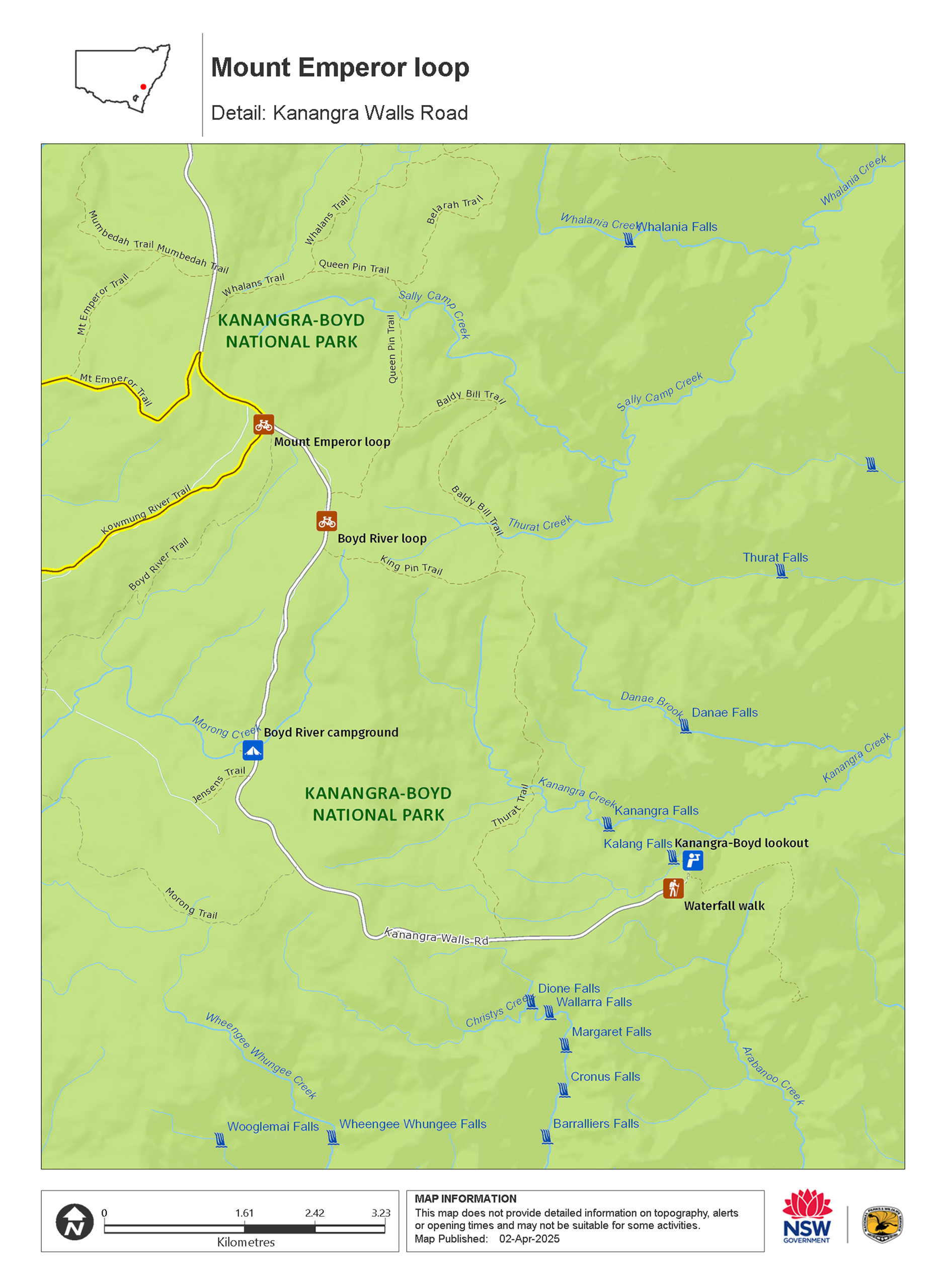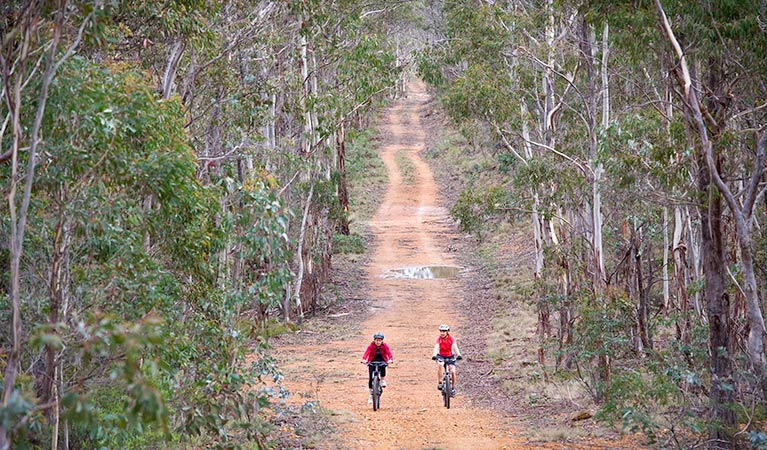Overview
A scenic 12.5km ride across the Boyd Plateau, Mount Emperor loop gives mountain bike riders the opportunity to explore some of the lesser-known corners Kanangra-Boyd National Park.
- Distance
- 12.5km loop
- Time suggested
- 1hr
- Grade
- Medium
- What to
bring - Hat, sunscreen
- Please note
- This park is in a remote location and the weather can be extreme and unpredictable, so please ensure you’re well-prepared for your visit.
- There is limited mobile reception in this park
- It's a good idea to fill in the free trip intention form and hire a PLB before you set out. Bring a topographic map and compass or GPS.
- Remember to take your binoculars if you want to go birdwatching
Mount Emperor loop is an ideal mountain biking route that follows little-used 4WD trails through upland swamps on the Boyd Plateau.
Not far from Katoomba or the Jenolan Caves, Mount Emperor loop ride is a great way to get off the beaten track and into the surrounding wilderness. Mount Emperor loop is also great for visitors who have already explored Boyd River loop and are seeking a challenge as this trail is shorter but slightly more difficult by comparison.
Get your heart pumping along Ben Lomond trail, and follow until you reach Emperor Creek trail where you’ll find a gradual descent to the cool shade of Box Creek. From here the track climbs back up to intersect the Kowmung River trail where you will enjoy the flat 4.5km back to where you started.
Be sure not to whizz through Mount Emperor loop too fast as you will miss out on delightful scenic views and idyllic photography opportunities along the way.
If you are looking for a place to rest, a leisurely picnic lunch is perfect to take advantage of the natural surroundings on Mount Emperor loop. With the rich birdlife culture within Kanangra-Boyd National Park, you can also enjoy a spot of birdwatching while your heart isn’t under the pump.
Also see
-

Boyd River loop
Take the easy route to peaceful cycling on Boyd River loop, a 21km journey that follows fire trails and roads in Kanangra-Boyd National Park.
-

Boyd River campground
Try camping beneath the snow gums at peaceful Boyd River campground, on the banks of Morong Creek.
-

Dingo Dell campground
Stay at the remote and peaceful Dingo Dell campground when you’re on a family 4WD adventure in Kanangra-Boyd National Park. Enjoy hiking, mountain biking, swimming in the summer and stargazing all year round.
Map

Map

Map legend

Local alerts
For the latest updates on fires, closures and other alerts in this area, see https://www.nationalparks.nsw.gov.au/things-to-do/cycling-trails/mount-emperor-loop/local-alerts
General enquiries
- National Parks Contact Centre
- 7am to 7pm daily
- 1300 072 757 (13000 PARKS) for the cost of a local call within Australia excluding mobiles
- parks.info@environment.nsw.gov.au
Park info
- in Kanangra-Boyd National Park in the Sydney and surrounds and Country NSW regions
Kanangra-Boyd is always open, but may have to close at times due to poor weather or fire danger.
Visitor info
All the practical information you need to know about Mount Emperor loop.
Getting there and parking
Get driving directions
On entering Kanangra-Boyd National Park from Jenolan:
- Follow Kanangra Walls Road for 15km
- Mount Emperor loop begins at the Kowmung River trail junction on the right
Road quality
Check the weather before you set out as the road to Morong Falls trail can become boggy when it rains.
Parking
Parking is available beside the road at the Boyd River trail junction, just past the Kowmung River trail on Kanangra Walls Road.
Best times to visit
There are lots of great things waiting for you in Kanangra-Boyd National Park. Here are some of the highlights.
Spring
A beautiful time of year to enjoy hiking and mountain biking; the temperature isn't too hot. The Kanangra Classic, a weekend of outdoor adventure, takes place at Jensens Farm near Boyd River Campground in October. The event includes mountain bike enduros, a social ride and an ultramarathon.
Summer
Take the family camping in the mountains. This is best time of year for canyoning, as well as spotting some of the park's wildlife including kangaroos, echidnas, wombats and lyrebirds.
Winter
With cold temperatures during these months, including the possibility of snow, it's best to walk and mountain bike as part of a day trip. You'll be rewarded with the yellow Kanangra wattle beginning to bloom in late winter.
Weather, temperature and rainfall
Summer temperature
Average
10°C and 23°C
Highest recorded
34.5°C
Winter temperature
Average
-2ºC and 10ºC
Lowest recorded
-10.1ºC
Rainfall
Wettest month
June
Driest month
March
The area’s highest recorded rainfall in one day
200.3mm
Facilities
- Drinking water is limited or not available in this area, so it’s a good idea to bring your own.
- You’re encouraged to bring gas or fuel stoves, especially in summer during the fire season.
Maps and downloads
Permitted
Fishing
A current NSW recreational fishing licence is required when fishing in all waters.
Prohibited
Gathering firewood
Pets
Pets and domestic animals (other than certified assistance animals) are not permitted. Find out which regional parks allow dog walking and see the pets in parks policy for more information.
Smoking
NSW national parks are no smoking areas.
Learn more
Mount Emperor loop is in Kanangra-Boyd National Park. Here are just some of the reasons why this park is special:
Action adventure

Hardcore hiker? Mad for mountain biking? There's something for whatever level of adventure you desire. Fire trails that wind throughout the park can be explored by 4WD or bicycle. For those who are handy with a map and compass, there's plenty of opportunity for self-reliant bushwalking. There are also marked trails that take in the captivating landscape which are even suitable for the kids. You might even want to throw in a line at Kowmung River to see if you can hook a trout.
- Boyd River loop Take the easy route to peaceful cycling on Boyd River loop, a 21km journey that follows fire trails and roads in Kanangra-Boyd National Park.
- Kanangra-Boyd lookout You can see for miles at Kanangra-Boyd lookout, an easily accessible viewpoint overlooking Kanangra Walls and Mount Cloudmaker.
- Mount Emperor loop A scenic 12.5km ride across the Boyd Plateau, Mount Emperor loop gives mountain bike riders the opportunity to explore some of the lesser-known corners Kanangra-Boyd National Park.
Amazing formations

You can see many unique formations in Kanangra-Boyd National Park, including Thurat Spires, Kanangra Walls, Mount Colong, and waterfall systems - Kalang, Kanangara and Morong. The park also features a series of karst landforms that can be explored by those with caving experience.
- Kalang Falls walk Kalang Falls walk in Kanangra-Boyd National Park offers marvellous views of the cascading water at Kanangra and Kalang Falls.
- Kanangra-Boyd lookout You can see for miles at Kanangra-Boyd lookout, an easily accessible viewpoint overlooking Kanangra Walls and Mount Cloudmaker.
Preserving nature for future generations

There was a time when Kanangra-Boyd was in danger from logging and the extraction of lime. That all changed after a five-year conservation effort resulted in it being declared part of Greater Blue Mountains Area World Heritage Property in 1972.
Wonderful wilderness

High plateaus and sheltered slopes mean Kanangra-Boyd has a diverse range of plantlife, some of it unique to the national park. Heath and mallee dominate the areas exposed to wind and weather, while tall snow gum forests can also be found in the park. Look for the yellow Kanangra wattle that grows only on the rivers - it flowers from early spring to late winter. The wildlife population is extensive too. Keep your eyes peeled for red-necked wallabies, which thrive in this area. Honeyeaters, wrens and fruit-eating pigeons are just some of the 195 species of birds that can be spotted in the park on a daily basis.
- Kalang Falls walk Kalang Falls walk in Kanangra-Boyd National Park offers marvellous views of the cascading water at Kanangra and Kalang Falls.
- Kanangra-Boyd lookout You can see for miles at Kanangra-Boyd lookout, an easily accessible viewpoint overlooking Kanangra Walls and Mount Cloudmaker.
Plants and animals protected in this park
Animals
-

Spotted-tailed quoll (Dasyurus maculatus)
The spotted-tailed quoll is the largest remaining carnivorous marsupial on the Australian mainland. It’s protected as a vulnerable species in NSW.
-

Short-beaked echidna (Tachyglossus aculeatus)
One of only 2 egg-laying mammals in the world, the short-beaked echidna is one of the most widespread of Australian native animals. Covered in spines, or quills, they’re equipped with a keen sense of smell and a tube-like snout which they use to break apart termite mounds in search of ants.
-

Superb lyrebird (Menura novaehollandiae)
With a complex mimicking call and an elaborate courtship dance to match, the superb lyrebird is one of the most spectacular Australian animals. A bird watching must-see, the superb lyrebird can be found in rainforests and wet woodlands across eastern NSW and Victoria.

